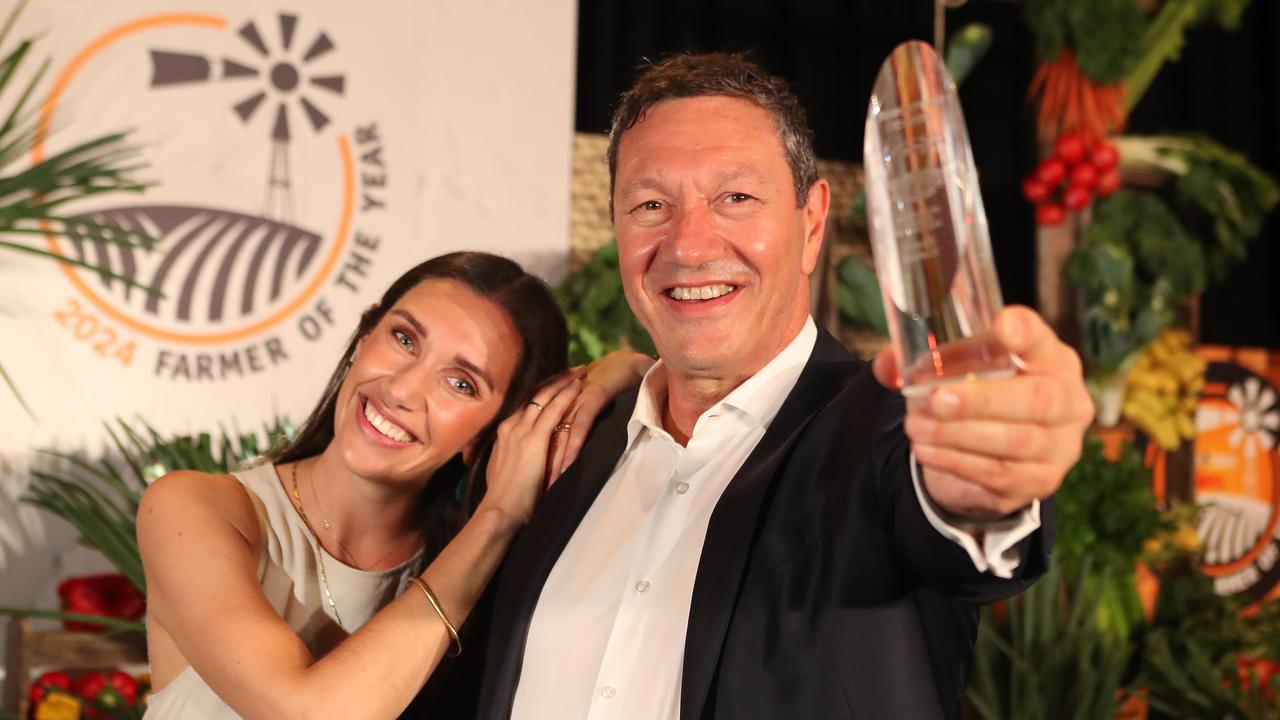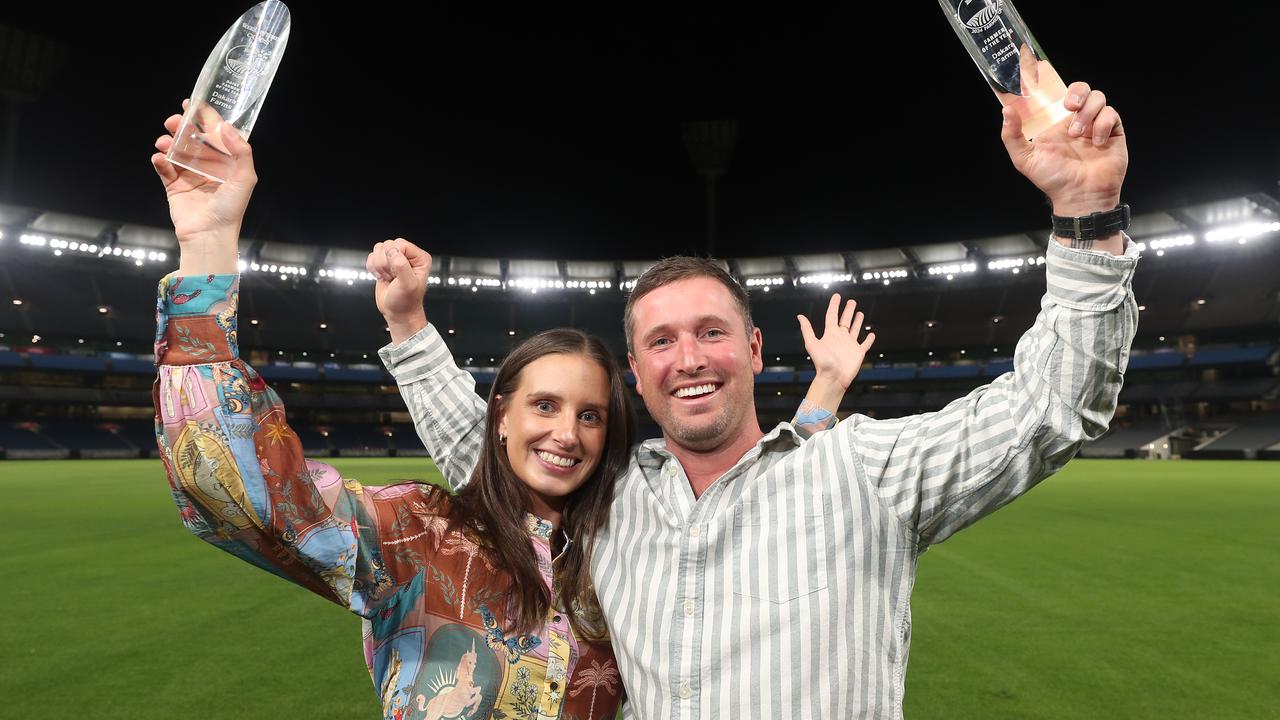Shearer-turned-farmer David Farley makes prime lambs work at Kybybolite
DAVID Farley is one of those names you hear when farmers talk about young up-and-comers.

DAVID Farley is one of those names you hear when farmers talk about young up-and-comers.
With his wife, Michele, the shearer-turned-large scale prime lamb producer runs 10,000 crossbred ewes on 2000ha — half of which is leased — in the South Australian mixed-farming district of Kybybolite.
Their main business is prime lambs from self-replacing composite ewes, finished on grass and in a feedlot.
Twenty five per cent of the business is cropping and much of the grain is used as sheep feed.
Four years ago the Farleys switched from buying first-cross ewes annually at the Naracoorte feature sales to breeding their own maternal composites.
It’s a move that has given them greater control over ewe size while improving their genetics and biosecurity.
David studied a diploma of agriculture at the University of Adelaide’s Roseworthy campus before returning home to his family’s small farm at Strathalbyn, where his parents, Roger and Jan, ran 1000 Merinos mated to White Suffolks.
David says the farm was “really only a one-man show”, so he went shearing for six years, gradually moving into farming.
In 2008, three-quarters of the Strathalbyn farm was sold to fund the purchase of the land at Kybybolite, which at 570mm is in a higher rainfall zone.
“We wanted to do half cropping, half livestock; it stimulates you to have diversity, you have to listen to what the country is telling you to get the best out of your land,” David said.
“We wanted to come to somewhere you could genuinely do both, and have a very efficient stock enterprise that you could push hard.”
Three years ago a nearby property was leased to expand the business.
Now, 45 per cent of the lambs are usually pasture-finished and the rest are grain finished. But this year, only 30 per cent will be grass-finished.
“We lamb on the second week of June — people here generally lamb on the 1st of May — we are much later which allows much higher stocking rates,” he said.
About 40 per cent of the 10,000 crossbred ewes are mated to Lambpro Maternal rams to produce replacement ewes, while the rest are mated Poll Dorsets.
“We’ve followed this program for four years and within another three years we’ll be into a full maternal composite pathway,” he said.

The ewe flock was originally a Border Leicester-Merino first cross.
“Initially we drafted off the best first-cross ewes, last year we drafted off all of our replacements from the maternals that had twins the year before, and now next year will be the first year we have more than 40 per cent of our sheep as maternals.”
Ewes are tagged according to management groups. If a ewe scans dry as a ewe lamb (all dry adult ewes are sold immediately), her white tag — which indicates she is part of the maternal flock — is removed and she reverts to the terminal flock.
Next, David will remove any sheep that does not scan early for twins (within the first two cycles) and move them into the terminal flock the following year.
The Farleys leave their rams running with their ewes in for an “extended” time, preferring a late-season lamb than a dry ewe.
“We lamb over 80 days but scan them into six management groups: early triplets, early twins, early singles, late twins, late singles and drys,” David said.
“That way we can have a tight lambing initially, 20-30 days, which is very important with high stocking rates.”
David prioritises pasture management to cater for the feeding requirements of each class. He has been using Ovastim — a reproduction booster — for five years and his twinning rate has risen from 60 to 75 per cent. Overall, the number of lambs weaned to ewes mated averages 130-135 per cent.
Lambing begins the second week in June.
“We’re averaging 80 per cent in-lamb in our ewe lambs in the first year, but want to work on that,” David said.
The stocking rate averages 6.8 crossbred ewes per hectare, year round, David said, but he “works on sheep numbers, not DSEs (dry sheep equivalents)”.
“One thing we don’t want to end up with is too many lambs in the feedlot,” he said.
“As soon as we’ve got a B-double (truck) load of lambs, 18-21kg, we just sell.”
In November, shearing begins with ewes, followed by lambs. By the start of December all lambs are sold or shorn.
David said each year was different in the feedlot.
“Nothing under 32kg goes into the feedlot; if lambs are lighter they are fed in the paddock,” he said.
“We generally put lambs into the feedlot in mid-December until the second week in February.”
With about 6000 lambs on feed, David studies markets closely.
“If we think there’s upside in late February-March, and have grain, we’ll sit on them to get them to 28kg; we did that last year and it worked well,” he said.
“With the feedlot, we’ve made zero dollars per lamb, but other years we’ve made $50; last year our lambs averaged 27kg, or $160 out of the feedlot, but that was extreme. A typical year might be $130. But lambs in the wool averaged $92.
“It’s easy to lose money in a feedlot without a professional system. Average profit we make is under $20 a lamb, but with big numbers it works.”
Looking ahead, David thinks lamb prices will be stronger after Christmas.
“However they will not grow at anywhere near the rate seen last year as people are sitting on a lot of lambs that are smaller and there’s much more restocker interest than last year,” he said.
David said the feedlot had risks. But if he did not have it and had to either sell half the lambs as stores or move lambing back to May so all lambs could be finished on grass, he would have to drop ewe numbers by 2000.
“I wouldn’t be making as much money; I’m better off lambing at the correct time of year with the correct stocking rate,” he said.
“You have to push the stocking rate until you find the sweet spot. When it tips you don’t get right growth rates when weaning, if you don’t wean lambs above 30kg at 90 days.
“When we started I looked at a few feedlots and copied the best system. You need good farmer networks to get to know top producers.”
David is heavily involved in the growing Mackillop Farm Management Group and said this had afforded him many opportunities to learn.
Leasing has been the easiest way to expand for the Farleys.
“It allows you to build up stock number, make a twostep process out of a onestep process when you do want to buy more land,” David said.
“Sure I’m not getting the capital gain, but I back myself and think I can make money out of my stock.”


